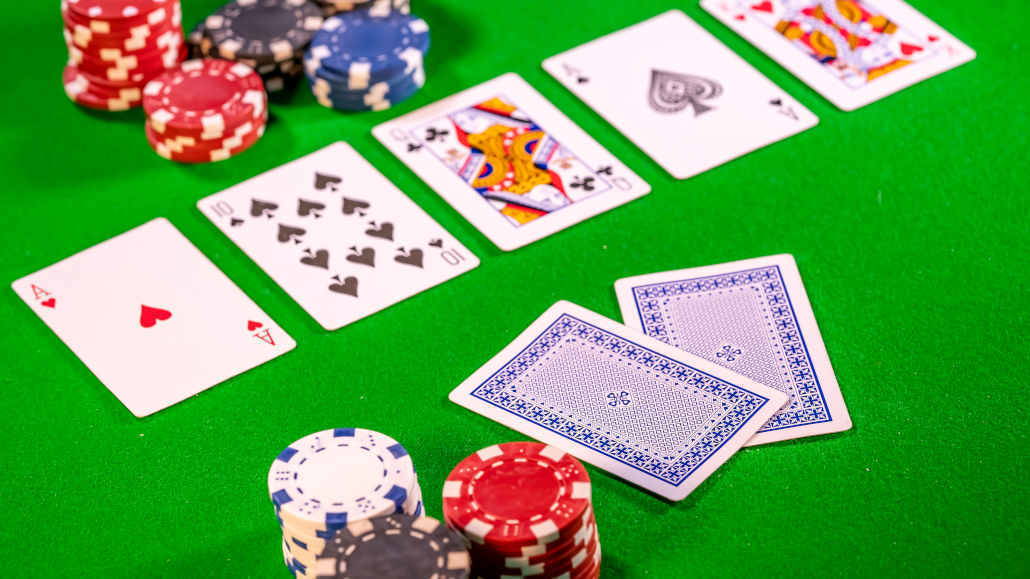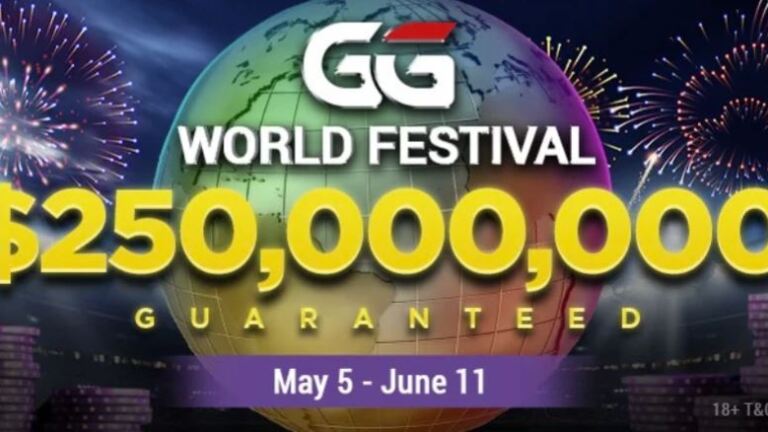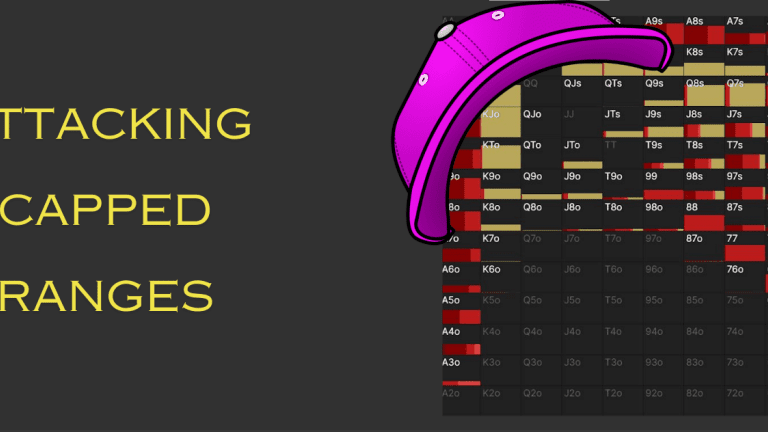We've arrived at a spot that is probably one of the most difficult of all; the river play out of position as the preflop aggressor. You'll find yourself in a difficult spot, especially in single-raised pots in a normal situation (with effective stacks 100bb deep). The game tree is already complex enough; you should have divided your range on prior streets. Now, you must do it again, and it is a challenging job to do. First, in theory, sometimes you need strong hands in your checking range; second, your opponent still has the chance to put a lot of pressure on you by betting or raising; and last but not least, the river card could shift equities drastically. We'll follow up on the spots we've discussed in the turn play and make the most sense for our river decisions.

Small Blind vs Big Blind at river
Let's start with the most common OOP spot, the blind versus blind play. First, we'll examine third barrel spots, where sometimes we arrive with a polarized and sometimes a merged range.
Remember, the ranges are wide in blind versus blind spots, so you probably have to make the thinner value bets you are used to and expect more bluff catching from your opponents.
When should you use third barrel at river
We'll follow up with two common scenarios here: you range c-bet the flop, barrel the brick turn, and have the chance to a third barrel. Two, you've already c-bet a polarized range on the flop, you continued on the turn, and now you have a decision to make on the river.
Range c-bet flop, turn barell and river play
So, you bet all the way on a  J
J  J
J  9
9  2 board, and the river is a total brick, let's say the
2 board, and the river is a total brick, let's say the  3 . When you have a strong value hand on the turn and the river card doesn't change anything, you can bet for value all of these hands, practically for any arbitrary sizing (usually a big one, 66% or more).
3 . When you have a strong value hand on the turn and the river card doesn't change anything, you can bet for value all of these hands, practically for any arbitrary sizing (usually a big one, 66% or more).
What is more problematic is which exact holdings and how many bluffs to have. Let's answer the mathematical background behind it real quick. As always in poker, it all depends on the circumstances. In this case, the betsize and the potsize will determine the' optimal' ratio between bluffs and value hands. The formula you might use is River bet size ÷ (Pot size after the turn betting round + River bet size + River call size).
For instance, if the pot is $100, and you make a 66% per cent ($66) bet on the river, then the' optimal' bluff frequency is 66 ÷ (100 + 66 + 66) = 28%. You can play around with this, replacing different bet sizes. You'll find that the bigger you bet, the more bluffs you could have in theory.
However, it's great to know the amount we should bluff; we still need to figure out how to choose our candidates. First, your opponent and her stats/playing style matter greatly. If she is overfolding to river bets, you can add more bluffs, and if she is defending way too many combos, you should consider giving up more hands (and, at the same time, adding more thin value).
Next, you must evaluate your hand in terms of showdown value. If you have a pair or an ace-high, they will have more showdown value than a missed straight draw, which is an 8-high by the river.
The characteristics of your actual holding are also important. Poker players often refer to their hands as good or bad blockers. In our example, a T8s has pretty bad blocker characteristics by blocking other possible missed draws like QT, KT and T8. This fact, combined with a lot of SD value, makes T8 a tough hand to play on the river and probably a bad bluffing candidate, theoretically speaking.
Another crucial factor is your opponent's range arriving at the river. In some cases, that range is so capped that you can go crazy about bluffing, and they'll have a hard time calling with weak, one-pair-type hands with low kickers. In our example, there should be plenty of Jx and some 9x combos that could call down three barrels. Also, consider what range you are representing. Here, you might go for value with an A9 or TT, sometimes with your overpairs, but mostly, you'll have Jx combos. Considering that you open somewhere between 38-50% preflop, that value part of your range is relatively narrow, so you must be careful not to go too wide with your bluffs.
How about a river card you didn't want to see, as it completes many possible draws? Sure, you have some of those draws, too, but still, you lose your advantage, and many of your hands that had massive value have no business betting anymore.
Let's examine the same board with a different runout:  J
J  J
J  9
9  Q
Q  T. On the turn, you might have bet a polarized range with a big sizing or a merged range with a smaller sizing. Either way, the river card complicates things even more. When you have a wide range of top pairs, over pairs, etc., you least wish for another equity shifting card. In general, you should bet a polarized range. In this particular runout, you may bet a straight or better for value and the worst showdown hands as a bluff, such as
T. On the turn, you might have bet a polarized range with a big sizing or a merged range with a smaller sizing. Either way, the river card complicates things even more. When you have a wide range of top pairs, over pairs, etc., you least wish for another equity shifting card. In general, you should bet a polarized range. In this particular runout, you may bet a straight or better for value and the worst showdown hands as a bluff, such as  A7o or small pocket pairs with a diamond.
A7o or small pocket pairs with a diamond.
Against good opponents, you'll have to protect your checking range as well, so how do you do that? Usually, it would help to choose such a strong hand that blocks Villain calling range; here, a QJ, JT or a J9, for instance, and a hand that can check-raise for value to maximize EV. Low-stakes players generally are more passive than optimal, which means they bet for a thin value less often and bluff less often. These conclude that usually, you want to bet your super strong hands yourself.
Polar c-bet, turn barrel and river plays
A typically misplayed flop, an ace-high containing two low cards. It is somewhat connected; many of your holdings are unhappy with an ace (just think about TT-KK), a higher top pair, etc, can dominate your top pairs. So, on an A
A  8
8  7 board, you should c-bet with a polar range and probably with a big sizing.
7 board, you should c-bet with a polar range and probably with a big sizing.
When the runout is clean, the same applies as above. Namely, your value hands are still ahead most of the time, so any large size or overbet is on the table. Your best bluffs will be those with the lowest showdown value or those blocking the strongest possible bluff-catching hands.
So the runout is something like A
A  8
8  7
7  2
2  2 ; your AJ is probably still the best hand in the majority of the time. Your best bluffs will be like 65s and 54s with the lowest SD value or JTs and JTo as they block the strongest Ax holdings that might bluff catch you, such as AJ or AT.
2 ; your AJ is probably still the best hand in the majority of the time. Your best bluffs will be like 65s and 54s with the lowest SD value or JTs and JTo as they block the strongest Ax holdings that might bluff catch you, such as AJ or AT.
How about EQ shifting rivers? For example, on  A
A  8
8  7
7  2, the river is the
2, the river is the  6 . Both players will have many flushes, and the Small Blind advantage of strong top pairs, two-pairs, and sets is decreased. Still, these hands might gain value against a variety of hands. Don't forget that ranges are pretty wide, which means many combos. However, the bigger you bet, the more you polarize yourself to a point where you only get called by stronger hands (flushes). The adequate approach will be a small sizing with all the hands you wish to bet.
6 . Both players will have many flushes, and the Small Blind advantage of strong top pairs, two-pairs, and sets is decreased. Still, these hands might gain value against a variety of hands. Don't forget that ranges are pretty wide, which means many combos. However, the bigger you bet, the more you polarize yourself to a point where you only get called by stronger hands (flushes). The adequate approach will be a small sizing with all the hands you wish to bet.
Of course, there are infinite possibilities to reach the last street. The examples above should serve as a guideline for what factors to consider, what the extremes are and how to approach the spot in general.
Summary
In this article, we studied river play as the preflop opener in blind versus blind spots, focusing on the third barrel. Understanding how ranges interact with the board takes a lot of practice, especially in scenarios with wide ranges such as the SBvBB. However, now you have a rough idea of how to approach clean runouts that benefit the preflop aggressor and what to do on EQ shifting cards that, in most cases, are better for the Big Blind. Remember, in theory, you should protect checking ranges even in very favorable spots. Nevertheless, your opponents will most likely deviate so much from the optimal bluffing and value betting frequencies that you should consider being more greedy in most spots.
There is more to come. In continuation, we'll look at the plays after delayed c-betting on the turn and what cards you should hold in these spots. The bet-check-bet and the check-check-bet lines are on the plate last, but they are not the least important.





















